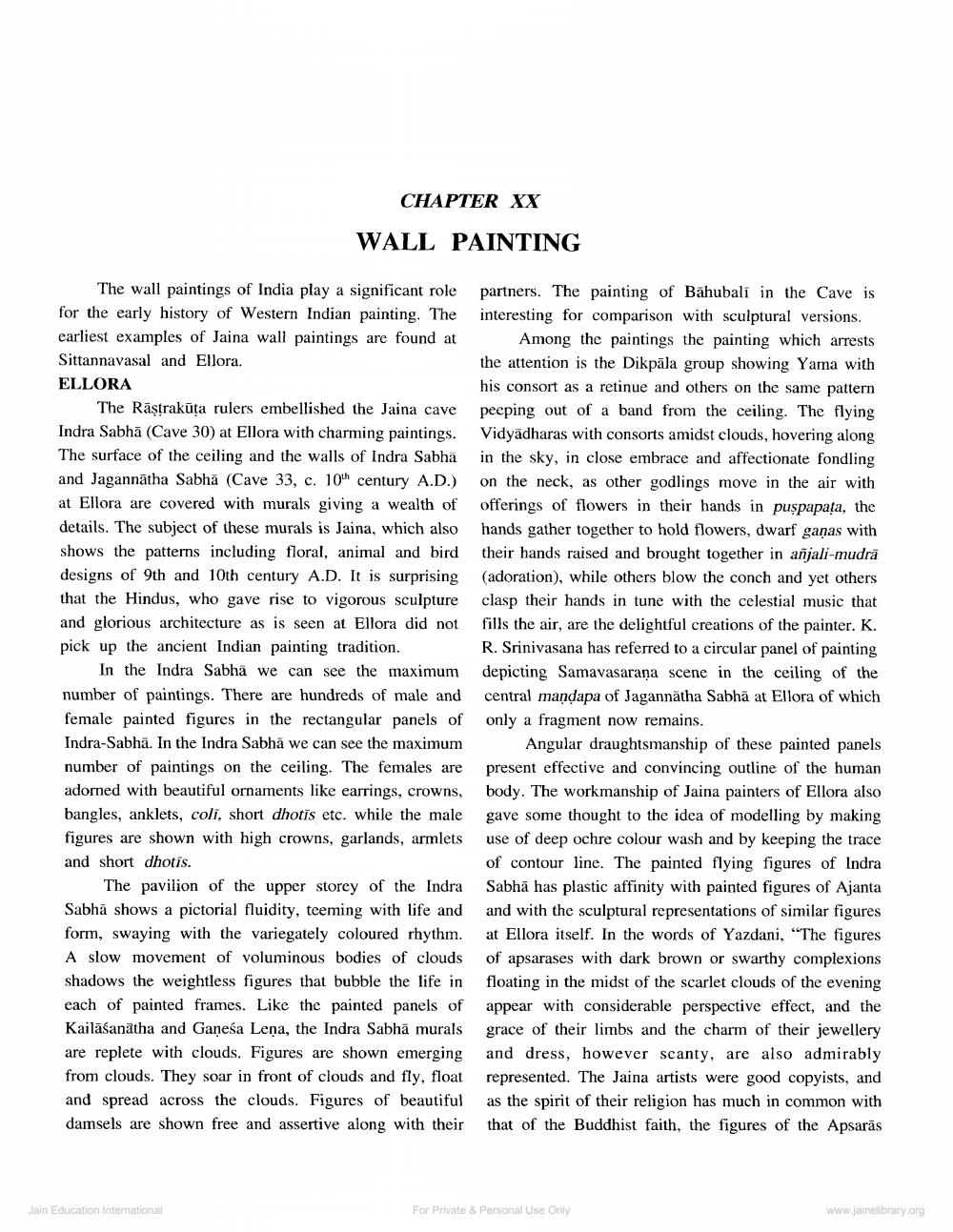________________
CHAPTER XX
WALL PAINTING
The wall paintings of India play a significant role for the early history of Western Indian painting. The earliest examples of Jaina wall paintings are found at Sittannavasal and Ellora. ELLORA
The Rāştraküţa rulers embellished the Jaina cave Indra Sabhā (Cave 30) at Ellora with charming paintings. The surface of the ceiling and the walls of Indra Sabha and Jagannātha Sabha (Cave 33, c. 10h century A.D.) at Ellora are covered with murals giving a wealth of details. The subject of these murals is Jaina, which also shows the patterns including floral, animal and bird designs of 9th and 10th century A.D. It is surprising that the Hindus, who gave rise to vigorous sculpture and glorious architecture as is seen at Ellora did not pick up the ancient Indian painting tradition.
In the Indra Sabha we can see the maximum number of paintings. There are hundreds of male and female painted figures in the rectangular panels of Indra-Sabhā. In the Indra Sabha we can see the maximum number of paintings on the ceiling. The females are adorned with beautiful ornaments like earrings, crowns, bangles, anklets, coli, short dhotis etc. while the male figures are shown with high crowns, garlands, armlets and short dhotis.
The pavilion of the upper storey of the Indra Sabhā shows a pictorial fluidity, teeming with life and form, swaying with the variegately coloured rhythm. A slow movement of voluminous bodies of clouds shadows the weightless figures that bubble the life in each of painted frames. Like the painted panels of Kailāšanātha and Ganesa Lena, the Indra Sabhā murals are replete with clouds. Figures are shown emerging from clouds. They soar in front of clouds and fly, float and spread across the clouds. Figures of beautiful damsels are shown free and assertive along with their
partners. The painting of Bahubali in the Cave is interesting for comparison with sculptural versions.
Among the paintings the painting which arrests the attention is the Dikpāla group showing Yama with his consort as a retinue and others on the same pattern peeping out of a band from the ceiling. The flying Vidyadharas with consorts amidst clouds, hovering along in the sky, in close embrace and affectionate fondling on the neck, as other godlings move in the air with offerings of flowers in their hands in pușpapata, the hands gather together to hold flowers, dwarf ganas with their hands raised and brought together in añjali-mudra (adoration), while others blow the conch and yet others clasp their hands in tune with the celestial music that fills the air, are the delightful creations of the painter. K. R. Srinivasana has referred to a circular panel of painting depicting Samavasaraṇa scene in the ceiling of the central mandapa of Jagannatha Sabha at Ellora of which only a fragment now remains.
Angular draughtsmanship of these painted panels present effective and convincing outline of the human body. The workmanship of Jaina painters of Ellora also gave some thought to the idea of modelling by making use of deep ochre colour wash and by keeping the trace of contour line. The painted flying figures of Indra Sabhā has plastic affinity with painted figures of Ajanta and with the sculptural representations of similar figures at Ellora itself. In the words of Yazdani, "The figures of apsarases with dark brown or swarthy complexions floating in the midst of the scarlet clouds of the evening appear with considerable perspective effect, and the grace of their limbs and the charm of their jewellery and dress, however scanty, are also admirably represented. The Jaina artists were good copyists, and as the spirit of their religion has much in common with that of the Buddhist faith, the figures of the Apsarās
Jain Education Intemational
For Private & Personal Use Only
www.jainelibrary.org




